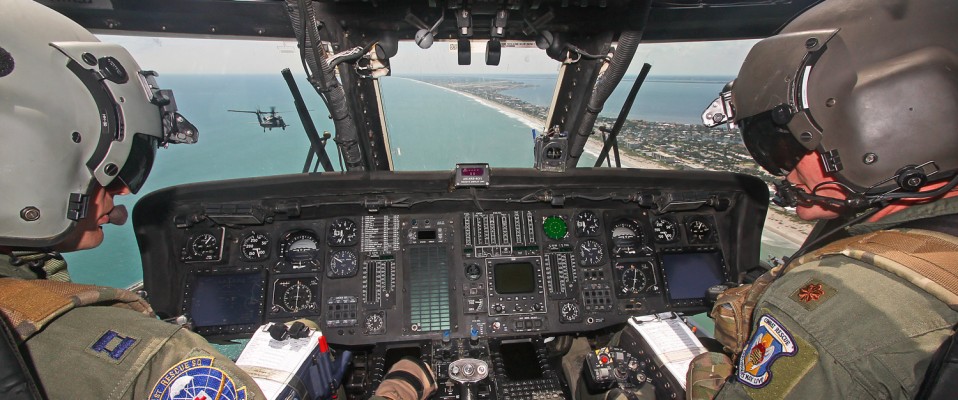INSIDE U.S. SPACE LAUNCH SUPPORT WITH THE 920th RESCUE WING
Article and Photos by Mike Killian
I
The Unit
The 920th Rescue Wing serves as an Air Force Reserve Command combat-search-and-rescue unit – responsible for a variety of demanding missions and ready to deploy at a moment’s notice, trained to perform some of the most highly-specialized operations in the Air Force. Their elite team of Pararescuemen, better known as PJ’s, are among the most highly trained emergency trauma specialists in the U.S. military. Elite graduates of the so-called “Superman School”, they are capable of performing life-saving missions anywhere in the world, at any time.
USAF video/ 920th Rescue Wing
In addition to combat search and rescue operations, the 920th also provides search-and-rescue support for civilians at sea who are lost or in distress, as well as providing world-wide humanitarian and disaster-relief operations supporting rescue efforts in the aftermath of disasters such as earthquakes, floods, and hurricanes. When a covert four-man Navy SEAL team was ambushed and surrounded in a Taliban counter attack high in the Hindu Kush Mountains of Afghanistan in the summer of 2005, the 920th was who Special Ops command called to perform the rescue.
With such expertise it’s no surprise that the 920th has always been the primary rescue force serving as NASA’s “guardians of the astronauts”. Their relationship with NASA and the U.S. Space Program began in 1961, and they have been providing contingency response for a variety of emergencies that could have potentially come up during every crewed or un-crewed space launch (or shuttle landing) ever since.
America’s human spaceflight program is currently in transition since the retirement of NASA’s space shuttle fleet in 2011. SpaceX and Boeing both hold multi-billion dollar Commercial Crew contracts to fly astronauts to and from the International Space Station (ISS) for NASA, but their spacecraft, the Crew Dragon and CST-100 Starliner, will not be ready to fly those missions and return human spaceflight to American soil until 2017. In the meantime, NASA is 100% dependent on Russia to fly American astronauts to and from the $100 billion orbiting science outpost.
Besides the ISS, NASA is also under Congressional orders to lead the nation on a journey to Mars, and currently developing what will eventually evolve into the largest and most powerful rocket in history, the Space Launch System (SLS), to make human spaceflight missions beyond the moon a reality beginning in the first half of the next decade.
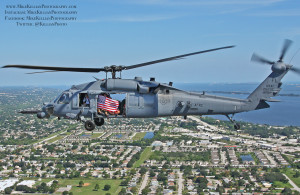 But the first SLS launch won’t happen until at least late 2018, and the first crewed launch won’t take place until any time between 2021 and 2023.
But the first SLS launch won’t happen until at least late 2018, and the first crewed launch won’t take place until any time between 2021 and 2023.
So the PJ’s themselves are currently on standby to provide human spaceflight rescue support for at least another couple years, but the 920th’s role supporting unmanned rocket launches for the USAF 45th Space Wing from the Cape is still as active and important as it has ever been. Both SpaceX and United Launch Alliance (ULA) keep an active flight manifest of NASA, commercial and DOD missions, and between both companies the launch rate on Cape Canaveral AFS is steady at one launch a month – sometimes two.
Rescue Wing Airmen continue to work closely with the 45th Space Wing, NASA, the Naval Ordinance Test Unit, and civilian space companies providing safety and security on the Eastern Range for every launch.
Assignments
I’ve had the privilege to work with the 920th on several assignments over the years, seeing for myself their unique and important responsibility supporting America’s space program. I’ve tagged along on search-and-rescue demonstrations on their HH-60G Pave Hawks and C-130 “Kings”, and was the first, and so far only, photojournalist to fly along on operational space launch support missions.
Most recently I worked with the 920th to conduct a unique photo shoot with two Pave Hawk flight crews positioned “between” a rocket launching. Lt Col Robert Haston, 301st RQS Safety and Space Ops, orchestrated the specific flight profile, and worked with 920th Public Affairs, USAF, NASA, and ULA (the rocket) for approvals to “photobomb” the launch.
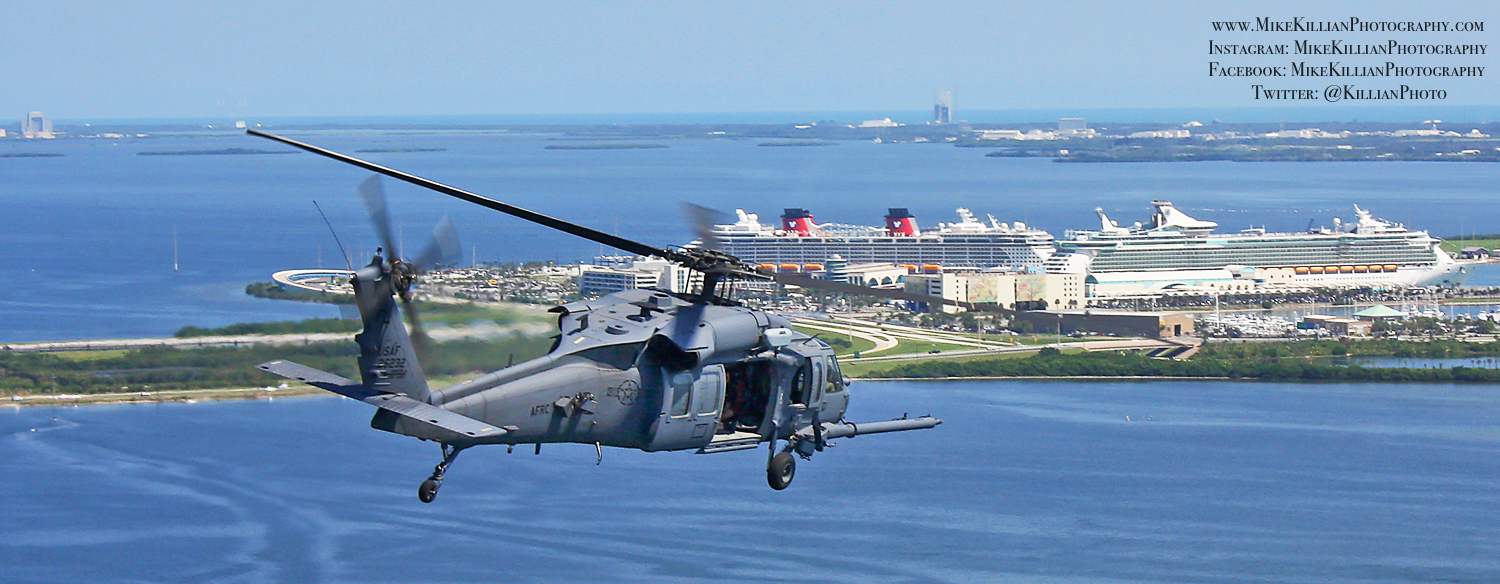
The plan was for both flight crews to arc around to a point about 1.5 miles behind the pad and track west towards NASA’s iconic Vehicle Assembly Building (VAB), which is the highest point on the flat landscape at 525 feet tall, flying at 200-500 feet above the ground at 115 mph before turning away once the rocket climbed through 500 feet.
Haston flew the flight profile several days prior, and plotted my shooting location on the roof of the VAB using GPS. Both flight crews used GPS to keep them within about 20 feet of centerline. Coincidentally, the launch itself, courtesy of Launch Complex 41 (SLC-41) and ULA’s Atlas-V rocket, was to place the GPS 2F-11 satellite into orbit.
A little bend in the mangroves near a canal between SLC-41 and the VAB served as an exact visual spot for both flight crews to aim for, hitting that about 5 seconds post launch and climbing through 300 feet to be center frame with the rocket as it climbed through 50 feet.
The HH-60G Pave Hawk is one of the most sophisticated helicopters in the world, described by many as a “Black Hawk on steroids.” They feature an upgraded communications and navigation suite that includes integrated inertial navigation/global positioning/Doppler navigation systems, and satellite communications. They are also equipped with an automatic flight control system, night vision, and a forward looking infrared system – known as color radar – that greatly enhances night low-level operations and allows them to fly in virtually any weather, day or night.
For Pave Hawk crews, searching in the dead of night for either boaters who have wandered too close to a rocket launch or soldiers trapped behind enemy lines is not a problem, and with the ability to perform mid-air refueling, flight crews can fly non-stop for 14 hours.
Most space launches have small “windows” to fly during every 24 hour period, but some launches have windows spanning many hours, while others last for only a second.
I can tell you from experience, airmen prefer the space launch missions with one-second launch windows.
In 2012, I tagged along with the 920th on a range-clearing mission to support the historic launch of the first commercial spacecraft to the ISS, the SpaceX Dragon, mission COTS-2, and although time has flown by since, the 920th’s missions supporting U.S. space efforts remains the same.
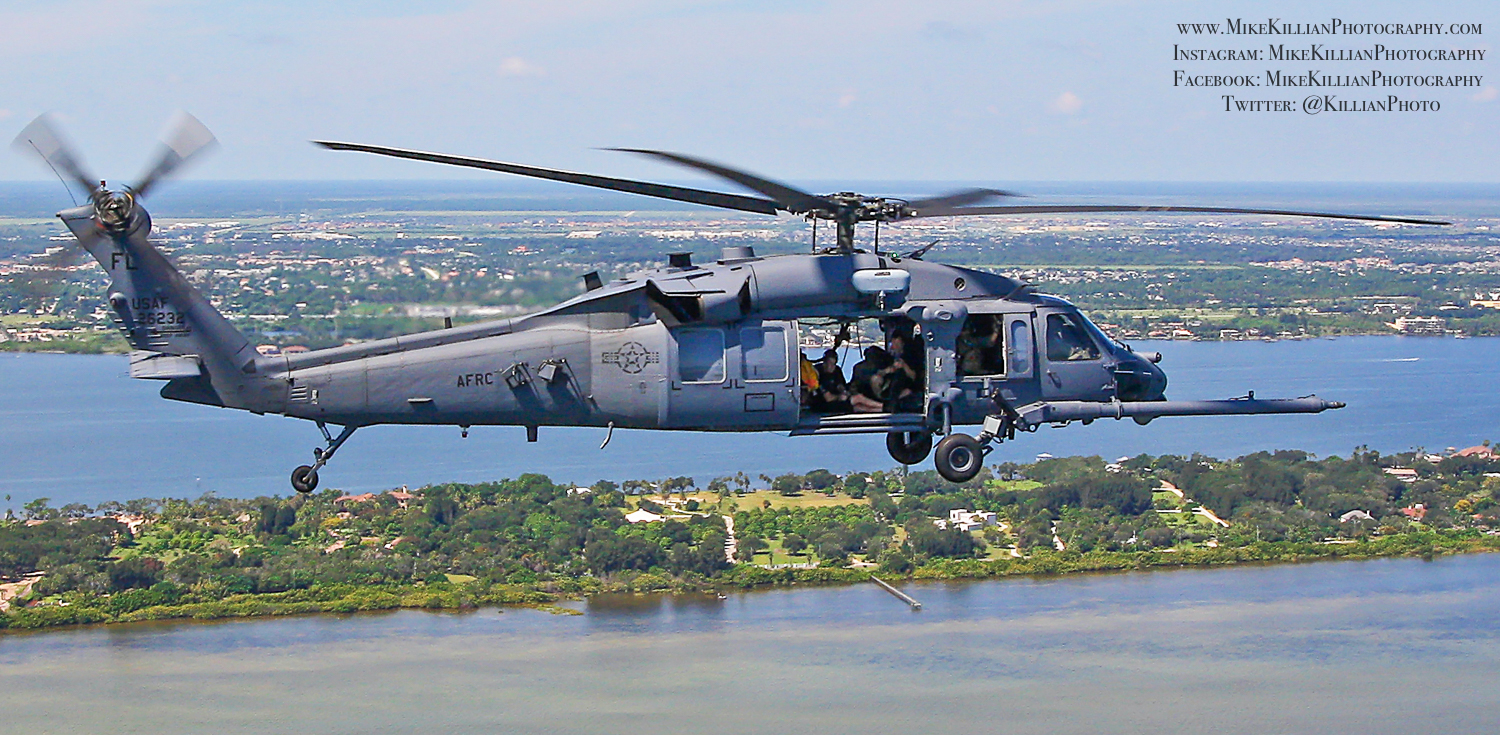
My “day” started at Patrick AFB at 12:30 a.m. May 19 for our flight supporting the first launch attempt, and proceeded to meet the crews and conduct the standard pre-flight brief. The briefing is incredibly thorough, nothing is missed, everything from contingency plans in case of an emergency, to radio frequencies, to the positions of both Pave Hawks at launch time is covered.
Both flight crews were also brought up to speed on the launch itself and the details of the COTS-2 mission. Our Pave Hawk would patrol north of the launch site, call sign Jolly 1. The other (Jolly 2) would patrol to the south of the launch site.
Once everyone was briefed we put on our flight gear and life support equipment, made sure our headsets worked properly and headed to the flight line, where two of the 920th’s fourteen Pave Hawks were being prepared for our mission.
After going over emergency scenarios, such as safely bailing out of a Pave Hawk, the APUs started and the choppers came alive. Colonel Jeffrey “SKINNY” Macrander, Commander of the 920th – responsible for the management and supervision of some 1,700 citizen airmen under his command, led the way.
“They usually like us to clear the box about two hours prior to launch. We don’t expect a whole lot of small boats out there, but we still get the commercial traffic that cruises back and forth,” said Col. Macrander minutes before our flight. “The big boats are always up on a maritime frequency, so we have a special radio in the Pave Hawk to call and talk to the boats. We’ll tell them to either speed up, change their course, or slow down so that they are not in the range for the launch window. We’ll call the coordinates into the control office at the Cape and they will plot it, do some math, and let us know what the boaters need to do to stay out of the range.”
“A lot of times the small boats are just fishing and not monitoring their radios,” added Macrander. “So sometimes we have to come down there and hover pretty close to get their attention and let them know with hand gestures to get on the radio.”
I would find out later that evening just how close they get to those small fishing boats not paying attention to their radios. We even hovered within less than 100 feet of a boater who was sound asleep, using the noise from the rotors and flashing bright spotlights on his boat to wake him up. I’ll never forget the look on his face as he emerged, rubbing his eyes open in disbelief and wearing nothing but boxer shorts. I can only imagine his thoughts waking up to an Air Force Pave Hawk circling him in the middle of the night.
The Launch
As for the launch, it scrubbed 0.5 seconds before liftoff. A second launch attempt was scheduled for three days later. In the meantime I had a different assignment on the other side of the country, but was already looking forward to my flight for launch attempt number two.
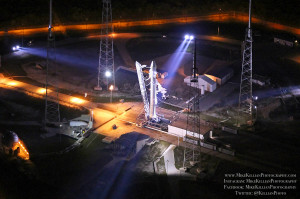 I returned Monday night, May 21, at 10:30 p.m. to do it all over again, but this time with Lt. Colonel Haston piloting our Pave Hawk. Haston has been supporting rocket launches for twenty years, piloting Pave Hawks and clearing the range for nearly every launch since 1995 – including Space Shuttle launches and landings. He has witnessed four rockets explode, so he understands first hand the importance of the 920th’s role in securing the Eastern Range for a launch.
I returned Monday night, May 21, at 10:30 p.m. to do it all over again, but this time with Lt. Colonel Haston piloting our Pave Hawk. Haston has been supporting rocket launches for twenty years, piloting Pave Hawks and clearing the range for nearly every launch since 1995 – including Space Shuttle launches and landings. He has witnessed four rockets explode, so he understands first hand the importance of the 920th’s role in securing the Eastern Range for a launch.
“I liken supporting rocket launches to fishing. There are a lot of nuances to range clearing that I’ve experienced over the years,” said Haston. “You get to know the type of boats and generally where they are going. A lot of different skills are involved depending on the type of boats you are dealing with. You may be dealing with a 1,000-foot freighter with a non-English speaking captain, or a brand new boat owner in a sailboat.”
Haston’s unique experience supporting launches is, as he puts it, “not the sort of thing you pick up in Air Force regulations,” but rather tricks of the trade.
We went through the same routine as we did for the first launch attempt, but this time the flight crew offered me a pair of $10k night-vision goggles so I could see what they see and shoot some photos to give viewers their perspective. The goggles help amplify the available light from the Moon and stars by up to 5,000 times onto a green phosphorous screen; the human eye can distinguish more shades of green than any other color.
There was no moon this night, and even 60 miles out over the ocean in the darkest black I have ever seen, where the horizons vanishes in the darkness as the night sky and ocean blend together, the goggles illuminated everything. I could even see the ripple of waves on the ocean’s surface.
We took to the skies two hours before launch, heading up the coast of Brevard County towards Cape Canaveral Launch Complex 40 (SLC-40), where SpaceX’s Falcon-9 rocket and Dragon cargo capsule stood fully fueled. We hovered a short distance away from the rocket for a few minutes to shoot exclusive photos from our unique vantage point before heading out to sea to clear boat traffic off the range. Our orders were to clear an area about 20 miles wide and 60 miles long around the launch site.
“They (range control) want us to clear 8-10 miles away from the azimuth. With a small rocket like this, it’s a small box, but because it’s brand new we need to keep it pretty clear,” said Haston.

Delta-IV rocket “aiming” for the moon as a Pave Hawk flight crew looks on (U.S. Air Force photo/Lt. Col. Rob Haston)
Earlier this year, a SpaceX Falcon-9 exploded at high altitude following liftoff from the Cape, so the 920th providing a larger box for newer launch vehicles, like the Falcon-9, proved to be a legitimate concern.
The night was fairly quiet, there was not much boat traffic getting in the way, but it was interesting to come within a couple hundred feet of a Carnival cruise ship and tell them to hurry up and get into Port Canaveral before the launch. I can only imagine the surprise people onboard must have felt when they saw, or heard, us circling overhead.
Lights go off in the Pave Hawk during night-ops. Small fluorescent tubes referenced our emergency exits, and the cockpit controls and displays – as well as the LCD screens on our cameras and cell phones – were the only lights we had. The pitch black view 60 miles out over the Atlantic allowed the Milky Way to shine brightly in the sky, and the sound of our rotors with no visual of anything was very strange, even eerie.
At one point I lost all reference of direction and could not even see the camera gear I had strapped to me.
Eventually the lights of America’s launch pads began to shine, and the unmistakeable sight of xenon lights on the Falcon-9 rocket came back into view. Even from 30 miles out, on a dark moonless night, NASA’s massive Vehicle Assembly Building stood out like a sore thumb – many of my friends and colleagues were on the roof to cover the historic launch.
Video by Mike Killian
We arrived at the shoreline north of KSC 20 minutes before launch, at which point we headed south along the beach and over Apollo/Shuttle launch pads 39B and 39A before hovering one final time next to the Falcon-9 for some last minute photos. We then proceeded to fly over NASA’s VAB, circling it from the back and bringing us within throwing distance of the rooftop and the press site. I could see some of the press corps flashing lights at us, their way of saying hello – we were close enough that I could see the light from the LCD screens on their cameras.
We positioned ourselves just north of the VAB and hovered with a great view of Falcon-9 as I sat at the edge of our Pave Hawk, listening to the launch commentary on our headsets as the bright booster roared away from the Cape, accelerating quickly through the atmosphere before vanishing as it climbed above the Pave Hawk’s rotors and out of view. Haston “tilted” our helo up so I could get in a few more shots before circling to position ourselves for another view, but by that time the rocket was already gone and already on the edge of space en route to the ISS.
With that, our mission was complete, and we headed south back to Patrick. As we approached Port Canaveral, the first stage of the Falcon-9 was already re-entering the Earth’s atmosphere, shining as bright as a comet as it plunged back to Earth. Haston decided to show me a little more of what the Pave Hawk could do, performing some maneuvers that most would describe as a roller coaster ride over Port Canaveral. I’m sure some of the folks on the ground wondered why a Pave Hawk was going crazy in the sky, but it sure was fun.
“Day launches are my preference as you encounter wildlife from the aircraft. You can see various fish, turtles and dolphins, and the occasional whale while flying over the wide open ocean,” said Haston. “But supporting any landmark launch is always a great thing to be a part of.”
These things we do, that others may live.”
Landing at Patrick was the end of my day, or night, depending on how you look at it. But for the 920th it was just the beginning, as they were getting ready to perform a search-and-rescue operation for a ship 1,200 miles off the coast of Florida in the area of Bermuda.
America’s space launch efforts supporting national security, science, exploration and the furthering of technological advancement and human knowledge depends, in part, on the 920th providing a safe and secure launch site for every mission, as well as search-and-rescue peace of mind for astronauts leaving the world, same as they have now for more than 50 years. And likely, for the next 50 years as well.
Their motto, “These things we do, that others may live.”


